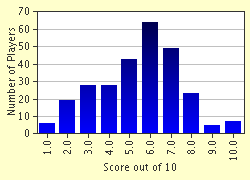Quiz Answer Key and Fun Facts
1. The origin of jigsaw puzzles can be traced back to the 1760s. Which profession was responsible for providing the inspiration for what has become a very popular pastime?
2. The name "jigsaw" has been applied to the puzzle as a tribute to the way the pieces were cut. All the original puzzles were made of wood and were cut with a saw - but not a jig saw. What type of saw was actually used?
3. Puzzles for adult use began to gain in popularity in the early 1900s. The USA had fully embraced the craze by 1908. These early puzzles were very challenging. What was the main reason for this?
4. Cardboard jigsaw puzzles were introduced in the late 19th century for childrens' puzzles only. There was very little movement towards producing adult jigsaw puzzles in any material but wood. While there were several reasons, the makers resisted the move. What was their main reason for doing so?
5. Making jigsaw puzzles with interlocking pieces was the next move for manufacturers. Several large companies were supplying products and one major player produced its "Pastime" series. The "Pastime" puzzles were so successful that in 1909 the company devoted its entire production schedule to producing the wooden puzzles. Which company was this?
6. As the method of die cutting was perfected in the early decades of the 20th Century, cardboard puzzles were able to be produced very cheaply. New promotional techniques were needed if this style of jigsaw was to seriously compete with the established wooden puzzles. What did puzzle producers do to encourage the public to try the less stylish cardboard product?
7. It was during the years of the Depression that the jigsaw was most popular. The puzzle was cheap recyclable entertainment and became widely available. What public institutions joined the craze by making the puzzles available to even more people?
8. The 1933 film "Me and My Pal" featured a jigsaw as one of the major cast members. A man preparing for his wedding is visited by his best man - bearing the gift of a puzzle. The hapless groom is already late but trouble rapidly escalates when the gift is opened and the two men begin to assemble the pieces.
The movie revolves around the finishing of the puzzle and all the efforts made to get the tardy husband-to-be to the church for the ceremony. "Just one more piece." Who were the two lead stars in the movie?
9. After World War 2 the popularity of the wooden jigsaw waned. They were expensive and time consuming to make. Improvements in the production of quality cardboard jigsaws meant that they soon became the preferred style of puzzle. One company extended the concept of a quality cardboard product by introducing a fine art series. Which American artist's work was featured on the puzzle billed as "the world's most difficult jigsaw puzzle"?
10. Inevitably, wooden puzzle devotees missed the comforting feel of a wooden puzzle piece and the satisfaction of assembling a solid well cut jigsaw. One company recognised this gap in the market and filled it. What did they do to create a unique market niche?
Source: Author
Nannanut
This quiz was reviewed by FunTrivia editor
Leau before going online.
Any errors found in FunTrivia content are routinely corrected through our feedback system.

